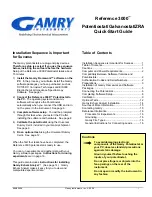
PROG
1.1
2.1
2.2
3.1
4.1
4.2
5.1
5.2
5.3
6.1
7.1
7.2
PROG
1.1
2.1
2.2
3.1
4.1
4.2
5.1
5.2
5.3
6.1
7.1
7.2
13
AMS2 (Level Mod. AMS2)
[Off, (KT, EXT)]
I (AMS2 Intensity)
[–99…+99]
S (AMS2 SW Start)
[–, 0, +]
A (AMS2 SW Attack)
[–, 0, +]
Refer to the preceding paragraphs “AMS1 (Level Mod.
AMS1)”–“A (AMS1 SW Attack).”
3.1–5c: Time Mod. (Time Modulation)
These parameters let you use alternate modulation to con-
trol the “T (Time)” parameters of the pitch EG.
AMS (Time Mod. AMS)
[Off, (KT, EXT)]
Indicates the source that will control the “T (Time)” parame-
ters of the pitch EG (
☞
p.212 “AMS List”).
I (AMS Intensity)
[–99…+99]
Specifies the depth and direction of the effect that “AMS
(Time Mod. AMS)” will have.
With a setting of 0, the pitch EG times will be just as speci-
fied by the “Pitch EG” (3.1–5a) settings.
The alternate modulation value at the moment that the EG
reaches each point will determine the actual value of the EG
time that comes next.
For example, the decay time will be determined by the alter-
nate modulation value at the moment that the attack level is
reached.
When this parameter is set to values of 16, 33, 49, 66, 82, or
99
, the specified EG times will speed up as much as 2, 4, 8,
16, 32, or 64 times respectively (or slowed down to 1/2, 1/4,
1/8, 1/16, 1/32, or 1/64 of the original time).
For example if “AMS (Time Mod. AMS)” is set to Velocity,
increasing the absolute value of “I (AMS Intensity)” will
allow strongly-played notes to increase the changes in pitch
EG “T (Time)” values. The direction of the change is speci-
fied by “A (AMS SW Attack)” and “D (AMS SW Decay).” As
you play more softly, the pitch EG times will more closely
approach the actual settings of the pitch EG.
A (AMS SW Attack)
[–, 0, +]
Specifies the direction in which “AMS (Time Mod. AMS)”
will affect the “A (Attack Time).” With positive (+) values of
“I (AMS Intensity),” a setting of + will cause the time to be
lengthened, and a setting of – will cause the time to be short-
ened. With a setting of 0 there will be no change.
D (AMS SW Decay)
[–, 0, +]
Specifies the direction in which “AMS (Time Mod. AMS)”
will affect the “D (Decay Time).” With positive (+) values of
“I (AMS Intensity),” a setting of + will cause the time to be
lengthened, and a setting of – will cause the time to be short-
ened. With a setting of 0 there will be no change.
■
3.1–5d: UTILITY
☞
“Write Program” (1.1–1c), “Copy Oscillator,” “Swap
Oscillator” (2.1–1d)
Indicates settings for filter 1, which controls the tone of oscil-
lator 1. You can select either a 24 dB/oct low pass filter with
resonance, or a 12 dB/oct low pass filter and 12 dB/oct high
pass filter connected in series.
When “Mode (Oscillator Mode)” (2.1–1a) is Single, Drums
you can use filter 1. When it is Double, you can use filters 1
and 2. In the case of Single and Drums, the filter 2 pages
cannot be selected.
4.1–1: Basic
Here you can specify the basic filter type used by oscillator
1, and set the cutoff frequency and resonance.
4.1–1a: Filter1
Type (Filter1 Type)
[Low Pass Resonance, Low Pass & High Pass]
Indicates the type of filter 1.
Trim
[00…99]
Adjusts the level at which the audio signal output from
OSC1 is input to filter 1A.
If the trim value is set too high, the sound may be dis-
torted if the Resonance is set to a high value or when
you play a chord.
4.1–1b: A (Filter A)
This filter cuts the high-frequency range above the cutoff fre-
quency. This is the most common type of filter, which cuts
the overtone structure to make a bright (sharp) tone darker
(mellow).
When “Type (Filter1 Type)” is Low Pass Resonance, the cut
will have a steeper curve.
Frequency (A Frequency)
[00…99]
Specifies the cutoff frequency of filter 1A.
Resonance (A Resonance)
[00…99]
This emphasizes the overtone components that lie in the
region of the cutoff frequency specified by “Frequency (A
Frequency),” producing a more distinctive sound. Increas-
ing this value will produce a stronger effect.
Pitch EG changes (Time) (AMS = Velocity, Intensity = positive (+) value)
Note-on
Note-off
Note-on
Note-off
Note-on
Note-off
A note played softly with “A”
set to + and “D” set to +
(settings of 3.1–5a: Pitch EG)
A note played strongly with
“A” set to + and “D” set to +
A note played strongly with
“A” set to – and “D” set to –
PROG 4.1: Ed–Filter1
4.1–1a
4.1–1b
4.1–1d
4.1–1c
Low Pass Resonance: 24 dB/octave
low pass filter with resonance
Low Pass & High Pass: 12 dB/octave
low pass filter and 12 dB/octave high
pass filter in series
Frequency
Level
Low Pass
12dB/oct
24dB/oct
Summary of Contents for TRITON Le
Page 1: ...2 E ...
Page 37: ...30 ...
Page 127: ...120 ...
Page 161: ...154 ...
Page 217: ...210 ...
Page 233: ...226 ...
Page 259: ...252 ...
















































